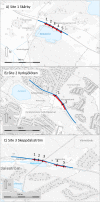Effectiveness of small road tunnels and fences in reducing amphibian roadkill and barrier effects at retrofitted roads in Sweden
- PMID: 31523500
- PMCID: PMC6714967
- DOI: 10.7717/peerj.7518
Effectiveness of small road tunnels and fences in reducing amphibian roadkill and barrier effects at retrofitted roads in Sweden
Abstract
Schemes to reduce road impacts on amphibians have been implemented for decades in Europe, yet, several aspects on the effectiveness of such schemes remain poorly understood. Particularly in northern Europe, including Sweden, there is a lack of available information on road mitigation for amphibians, which is hampering implementation progress and cost-effectiveness analyses of mitigation options. Here, we present data derived from systematic counts of amphibians during spring migration at three previous hot-spots for amphibian roadkill in Sweden, where amphibian tunnels with guiding fences have been installed. We used the data in combination with a risk model to estimate the number of roadkills and successful crossings before vs. after mitigation and mitigated vs. adjacent non-mitigated road sections. In mitigated road sections, the estimated number of amphibians killed or at risk of being killed by car traffic decreased by 85-100% and the estimated number successfully crossing the road increased by 25-340%. Data, however, suggested fence-end effects that may moderate the reduction in roadkill. We discuss possible explanations for the observed differences between sites and construction types, and implications for amphibian conservation. We show how effectiveness estimates can be used for prioritizing amphibian passages along the existing road network. Finally, we emphasize the importance of careful monitoring of amphibian roadkill and successful crossings before and after amphibian passages are constructed.
Keywords: Amphibians; Barrier effects; Effectiveness; Road mitigation; Roadkill; Sweden.
Conflict of interest statement
Silviu O. Petrovan is non-paid trustee (board of directors) of Froglife, a charity (non-profit) NGO.
Figures





Similar articles
-
Effectiveness of permanent drift fences in reducing roadkill risk of amphibians.J Environ Manage. 2024 Sep;368:122049. doi: 10.1016/j.jenvman.2024.122049. Epub 2024 Aug 11. J Environ Manage. 2024. PMID: 39128339
-
How do landscape context and fences influence roadkill locations of small and medium-sized mammals?J Environ Manage. 2019 Apr 1;235:511-520. doi: 10.1016/j.jenvman.2018.10.093. Epub 2019 Feb 1. J Environ Manage. 2019. PMID: 30711836
-
Daytime driving decreases amphibian roadkill.PeerJ. 2018 Aug 3;6:e5385. doi: 10.7717/peerj.5385. eCollection 2018. PeerJ. 2018. PMID: 30083473 Free PMC article.
-
Effects of road mortality and mitigation measures on amphibian populations.Conserv Biol. 2013 Aug;27(4):657-68. doi: 10.1111/cobi.12063. Epub 2013 May 6. Conserv Biol. 2013. PMID: 23647090 Review.
-
Demographic effects of road mortality on mammalian populations: a systematic review.Biol Rev Camb Philos Soc. 2023 Aug;98(4):1033-1050. doi: 10.1111/brv.12942. Epub 2023 Feb 26. Biol Rev Camb Philos Soc. 2023. PMID: 36843247
Cited by
-
Impacts and Potential Mitigation of Road Mortality for Hedgehogs in Europe.Animals (Basel). 2020 Aug 28;10(9):1523. doi: 10.3390/ani10091523. Animals (Basel). 2020. PMID: 32872180 Free PMC article. Review.
References
-
- Allaback ML, Laabs DM. Effectiveness of road tunnels for the Santa Cruz long-toed salamander. Transactions of the Western Section of the Wildlife Society. 2002;38/39:5–8.
-
- Andersson P, Lundberg J. Groddjursinventering och flytt vid väg 222, Skeppdalsström, Värmdö kommun, Stockholms län. Report from Trafikverket. 2015. http://media.triekol.se/2019/03/Andersson-Lundberg-2015-Groddjursinvente.... [10 June 2015]. http://media.triekol.se/2019/03/Andersson-Lundberg-2015-Groddjursinvente... [in Swedish]
-
- Banverket Vilda djur och infrastruktur – en handbok för åtgärder. Banverket Miljösektionen rapport 2005:5, Vägverket publikation 2005:72. 2005. https://trafikverket.ineko.se/Files/sv-SE/12025/RelatedFiles/2005_72_vil.... https://trafikverket.ineko.se/Files/sv-SE/12025/RelatedFiles/2005_72_vil... [in Swedish]
-
- Bonardi A, Manenti R, Corbetta A, Ferri V, Fiacchini D, Giovine G, Macchi S, Romanazzi E, Soccini C, Bottoni L, Padoa-Schioppa E, Ficetola GF. Usefulness of volunteer data to measure the large scale decline of “common” toad populations. Biological Conservation. 2011;144(9):2328–2334. doi: 10.1016/j.biocon.2011.06.011. - DOI
LinkOut - more resources
Full Text Sources

